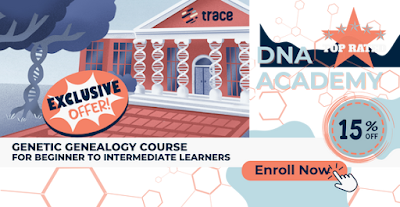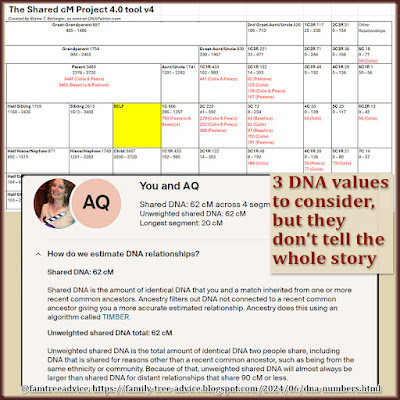I've been using Ancestry's subscription-based Enhanced Shared Matches on a one-month paid trial. This powerful tool is free on MyHeritage, but I have only 621 DNA matches on that website.
Using shared matches, I've identified and placed many DNA matches in my family tree. The process comes down to a few basic steps, so I want to share them with you today. It's the same process on MyHeritage as it is with Ancestry's Enhanced Shared Matches.
 |
| Use shared matches to see how DNA connects you to people near and far. |
Note that I'm not trying to find a missing direct ancestor through a DNA match. My family tree is missing one 3rd great grandmother and seven 4th great grandparents. All but one is missing because their hometown didn't keep civil records before 1861. No DNA match of mine will know their names.
So why do I bother spending time exploring my DNA matches? Two reasons:
- Filling in dead ends. When the available vital records end, I don't know who tons of cousins married. DNA matches can give me answers.
- Finding surprising connections. I've discovered cousins who lived near me at different times without my knowledge. Talk about a small world!
You may need to your matches to help you find a missing birth parent or an untraceable grandparent. For you, Ancestry's Enhanced Shared Matches will be far more valuable.
The Process for Using Shared Matches
- Start with the closest DNA match you haven't been able to identify.
- First, if they have a family tree posted, see if it contains any familiar names.
- Then check your shared matches to see if they're on the maternal or paternal side of your family tree. You may recognize one of your shared matches and know which side they're on. In my case, my parents have tested, so I can see which one is a match.
- Next, find their closest relations in the list of shared matches. If you see a shared match who is their parent, child, or sibling, make note of it on each person's profile. If you know one of their close matches, you should be able to work out this person's likely place in their family tree. For example, if you know their 1st cousin, then you can narrow down their grandparents to 2 couples.
- Now work through their relations to piece together an extended family. Use Ancestry and Facebook searches to find more clues. If you can ID their grandparents, build out that couple's descendants. Search for everything you can find.
 |
| If your family tree has a lot more holes than mine, you absolutely need to explore shared DNA matches. |
Tips to Use Throughout the Process
Labels. As you work through this process, label every match you identify with a consistent format. I call it a label because it appears in your list of DNA matches on Ancestry, but it's actually a note you attach to a match. I use a relationship abbreviation and our common ancestors' names. I'll include their real name if they're using an alias. For example:
4C1R thru 4Gs Tommaso Antonio Nigro (1793) and Brigida Donata Zeolla (1795)
This is my 4th cousin once removed (4C1R). Our common ancestors are my 4th great grandparents (4Gs) Tommaso and Brigida. I include the birth years of the ancestors because too many people in my family tree have the same name.
By using a consistent label format, it's easier to find people who share the same ancestors. You may want to add some other bits of useful information to your labels, including who their closest DNA relatives are.
Cousin Rules. Always keep in mind these basic rules for identifying common ancestors:
- 1st cousins share grandparents
- 2nd cousins share 1st great grandparents
- 3rd cousins share 2nd great grandparents
- 4th cousins share 3rd great grandparents, etc.
Do More Research. Your investigations may lead you to research several of your 3rd or 4th cousins' families. These are likely to be branches you haven't researched in full. With any luck, you'll make some discoveries that make the process worthwhile.
I love finding the obituaries of 3rd or 4th cousins and being able to build out their families. Then I search my DNA matches to see if anyone has the same newfound last names in their tree. Or I find the whole family on Facebook.
Not every DNA match has the power to help you in your genealogy research. Focus on those most likely to be helpful, and see what you can discover.
And speaking of DNA matches:
 |
| A 15% discount for readers of Fortify Your Family Tree! |







